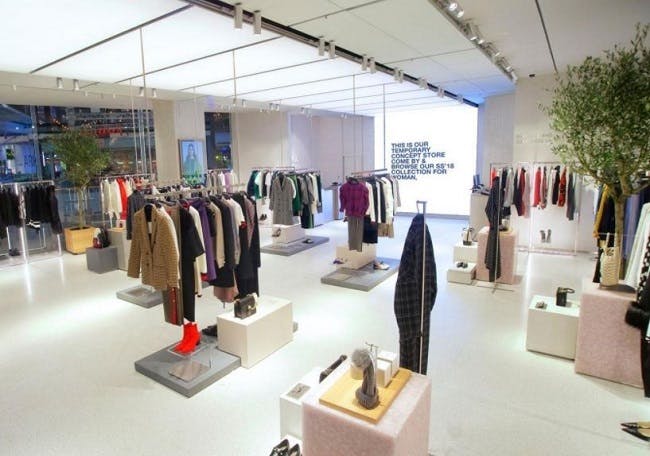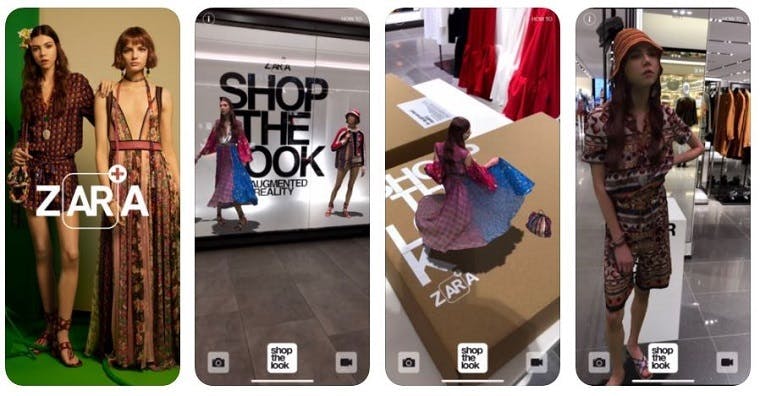From this it aims to offer customers a slicker, more streamlined, and ultimately enjoyable experience – as well as to combat the growing competition of ecommerce front-runners.
So, here’s a run-down of how Zara is using technology to gain an in-store edge, as well as what value it provides consumers.
Streamlining checkout with self-service
There’s no denying that Zara is one of the most in-demand retailers of the past few years. As of May 2017, it was ranked as the 51st most valuable brand in the world by Forbes, with sales increasing 13% to reach a record £602.7 million.
This is pretty evident in Zara stores, hence my frustrating experience last year. Shops are typically packed, often resulting in long queues for the fitting rooms and even longer ones to actually buy something (or god forbid, make a return).
In a bid to combat this, Zara has now launched self-service checkouts, allowing customers to skip the queue and buy for their items via do-it-yourself kiosks (à la Tesco).
However, the technology looks and feels much slicker than your average supermarket. Since being made a permanent feature of stores last September, I’ve given it a go a few times myself, and have actually left feeling quite impressed.
Instead of receiving the classic ‘unexpected item in bagging area’ alert, I enjoyed an intuitive and relatively easy-to-use experience. One of its best features is that it adds any item to your basket that you hold up in front of it (meaning no searching for or scanning pesky barcodes).
Zara has self checkout now!!!! I get to avoid unnecessary human interaction as much as possible ???????????? pic.twitter.com/zTcfhwwnBY
— A Boogie (@MetroBoolinn__) August 14, 2017
Has it abolished long queues entirely? Not quite, though (and this might just coincide with refurbished stores or more staff) the issue does seem to be lessening. Plus, the more customers try using the checkouts, the more it’s likely to ease even further.
Click-and-collect & fitting room tech
Recently, Zara introduced its first ever click-and-collect store in London’s Westfield Stratford. It’s only a pop-up (set to run until May) while its main store is being refurbished, but it could indicate that the retailer will be fully rolling out the feature in future.
Click-and-collect is not the only new technology on display at the pop-up, with other features also indicating what we might expect from the new flagship store.
Alongside online order collection, there’s also the option for customers to order and pay via their mobile phones in-store. What’s more, the fitting rooms include radio frequency identification technology (RFID), which offers up recommended or co-ordinating items when a customer scans something.
There’s certainly value in both these features, most notably click-and-collect – which Zara has surprisingly failed to invest in until now. The decision is certainly set to please online shoppers, as well as potentially increase orders made on the website.
The fitting room feature is also innovative and not something commonly seen on the high street – Mango is the only other example currently experimenting with it – meaning that it could be a key differentiator amid stiff competition for Zara.

Clothing comes to life with AR
Moving on to Zara’s latest initiative – augmented reality. This is particularly interesting, as while we’ve seen many mainstream beauty brands launching AR apps – capitalising on the consumer’s desire to test products before purchasing – the fashion industry has been less quick on the uptake.
So far, there have been just a few examples to appear (mainly from the luxury sector, such as Burberry) – also serving as a bit of fun rather than for product-based research.
Zara was recently one of the first mainstream retailers to launch an AR app, which is designed to bring clothes to life in-stores. By pointing cameras at sensors installed in windows, users of the app can see virtual fashion models strutting their stuff. Other AR imagery includes mannequins moving around and showcasing the brand’s new Studio Collection.
Once users have viewed the experience, there is also the option to buy the clothes featured directly through the app or in the store itself.

But will customers really use this kind of technology in-the-moment?
With Zara reportedly only running the initiative for a few weeks, it does seem more like a promotional campaign rather than something of real or long-term value for consumers. Again, this is also because the AR imagery is more geared around novelty and entertainment rather than having any real impact on the path to purchase.
The fact that the app asks users to share their photos and videos of the AR experience indicates that the retailer is hoping for a big splash on social.
Having said that, there’s certainly a demand for a share-worthy shopping experience. Other brands like Missguided have found success with an Instagram-able in-store CX. Meanwhile, Zara is clearly hoping the technology will lure millennials away from online-only retailers like ASOS and into its now hi-tech stores.
In conclusion…
Thanks to its increased focus on technology, Zara has certainly made steps to improve and enhance the customer experience in stores, with initiatives helping to counteract some of its previous problems.
Self-checkouts help to ease congestion and make buying items less frustrating, while fitting room technology makes the experience of trying on clothes much more fun and enjoyable. Similarly, the AR app is a fun and unique concept, which is sure to pique the interest of younger shoppers – or those wanting to try out something new.
So, while Zara’s future was never really in doubt, it’s recent investments are likely to boost success, as well as cement the loyalty of long-term fans.
Related articles:

Comments